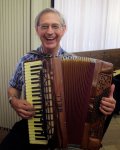Thank you, Matt, for your reply. Since you enjoyed my recordings, Ill give you two more:
http://xenharmony.wikispaces.com/space/showimage/Bach-WTC1-C_Minor.mp3
http://xenharmony.wikispaces.com/space/showimage/Satie-Gymnopedie1.mp3
Ill answer your questions in the order you asked them. You wrote:
> I dont immediately see the obvious superiority of this one on scales and arpeggios, but on the other hand I certainly have no reason to doubt you.
Youll see how much better the scale & arpeggio fingering patterns are on the Moschino system if you print my diagram, play the patterns on paper to learn them, then play them (silently, of course) on your accordions bass buttons. If you do that, youll find that everything can be played completely legato, including arpeggios.
> To help me understand, one thing that stands out (other than the separation of notes on the row by major thirds) is the number of rows and the duplication of notes on different rows. Do you typically make use of the full set of rows in playing this system?
Yes, I generally use all 8 rows of buttons, particularly when playing in a jazz style, in which I use a lot of open-position chords in the left hand, spanning anything from a tenth to two octaves (and occasionally beyond). If you listen carefully to the Satie Gymnopedie #1, youll notice that (except at the very end) I play only a single-note melody line in the right hand, with the left-hand accompaniment consisting of 4- and 5-note chords (since two buttons a fourth apart can easily be depressed with one finger!). Some of these chords span over two octaves, and its essential to use all 8 rows of buttons (diagonally) to reach these.
Id like to see the Moschino layout made available as a free-bass option on Roland V-Accordions, because it would make the system readily available to everyone. Its possible to get by with a Moschino-system layout on only 6 rows of buttons if one makes use of various work-arounds (mainly alternate fingerings; I would omit the two rows closest to the bellows). Even with that limitation it would still be much easier to play than any of the options Roland currently offers. Note that, even on the lowly FR-1X (which has only 72 bass buttons), the left hand would have a range of more than 4 octaves without switching registers!
> Another question, what right hand system do you use, is it laid out in the same way?
I have three professional-quality Moschino free-bass instruments, all with piano-accordion keyboard, LMMH dry tuning, and double tone chamber in the right hand. Two of these have a 45-note extended treble keyboard, including my best instrument (on which I made the recordings). All three instruments were made in Italy in the 1960s, two by Giuseppe Moreschi (imported by Crown Accordion Co. of Chicago) and one by Bell Accordion.
> Were there any past notable players particularly associated with the Moschino system?
Tom Patti was an excellent commercial/jazz player who played both the Stradella and Moschino free bass. I just looked him up on the internet and discovered that he passed away in January:
http://www.cressfuneralservice.com/obituary/121574/Thomas-Patti/
Thanks again for listening to my music.
--George Secor
Godfrey, IL


